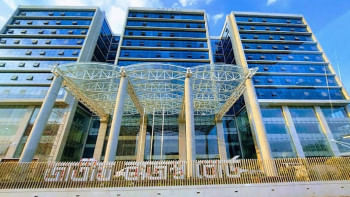Climate change: Is solar radiation management a feasible idea?

In an op-ed piece published in this newspaper on August 27, 2019, I discussed a number of methods within the context of Solar Radiation Management (SRM) as a way of mitigating some of the impacts of climate change. They are whitening low-level clouds, thinning the Cirrus clouds, injecting sulphate aerosols into the stratosphere, or putting sunshades (mirrors and/or reflectors) in outer space.
These geoengineering options would prevent some of the sunlight from ever reaching the Earth's surface or create more pathways for heat to escape from Earth. The reduced incoming solar radiation would offset some of the warming associated with increasing greenhouse gas (GHG) concentrations in the atmosphere.
But is SRM a good idea? Is it even feasible?
Despite the many benefits, some of the SRM approaches may have limitations and they could also be a route that could adversely affect the environment. However, it is not yet known what the adverse effects could be, or how damaging they would be. For good measure, some possible side-effects are known. What is also known is that the magnitude of the effects would be proportional to the scale of deployment of the technologies.
Seeding low-level clouds with seawater could produce changes in the amount and pattern of regional rainfall, as well as changes in ocean currents. On the other hand, thinning the high-altitude Cirrus clouds by injecting ice nuclei so that they become more transparent to the heat emitted by the Earth's surface, thereby producing a cooling effect, could result in changes to precipitation even in regions far away from geoengineered regions, underscoring the risks of remote side-effects, according to several studies.
One of the most widely discussed options for SRM involves emulating the effects of volcanic eruptions by injecting sulphate aerosols into the stratosphere. Spraying the stratosphere with aerosols could have "catastrophic effects in parts of the world already battered by natural disasters," as noted by researchers in an article published in Nature Communications in 2016.
They caution that it may disrupt the global hydrological cycle by increasing the frequency of cyclones and droughts in some parts of the world. The aerosols could also deplete the ozone layer that protects us from the harmful ultraviolet radiation. After the Mount Pinatubo eruption, there was a three-percent reduction in the amount of ozone in the atmosphere and rainfall decreased significantly in some parts of the world.
In the case of putting sunshades in orbit around Earth, the potential for unintended consequences such as drought is high. In particular, studies show that a reduction of 1.7 percent insolation could bring about important changes to regional climates, with warming at high latitudes while cooling below necessary level in sub-tropical regions. Furthermore, the prohibitively large cost of transportation of sunshades to outer space is seen as a shortcoming of this programme.
A fundamental problem with all SRM approaches is that they would require continual refreshing. Additionally, once they are put into operation, they have to be continued indefinitely in order to counterbalance the forcing associated with GHG emissions. It should be noted that SRM only offsets warming and does nothing to reduce GHG concentrations. Hence, once the programmes are stopped following their deployment, temperature changes caused by GHGs would manifest themselves suddenly and could rise beyond the level they otherwise would have.
The critics of SRM are troubled at the thought that our attempt to control the Earth's climate is possibly a matter of hubris rather than a desirable solution. Besides, before shifting the gear to overdrive, they would like to know whether the advantages of SRM outweigh the risks of climate change and how it would alter humanity's delicate relationship to nature.
Moreover, according to the critics, the wisdom of SRM remains highly controversial because of significant scientific and technological uncertainties. One of their strongest fears though is that SRM technologies may divert resources and momentum away from already waning efforts to reduce emissions of carbon dioxide.
More importantly, critics believe that within the social and political context, deployment of SRM technologies has the risk of "reckless pursuit of self-interest by powerful actors" on the world stage. In other words, the spectre of incompetent, negligent, or even malicious uses of the yet-to-be fully developed SRM technologies by rogue leaders alarms the critics.
Proponents of SRM hold that because the Earth's atmospheric system is large and complex, it is impossible to anticipate in advance all the consequences—detrimental and beneficial—of SRM. Nevertheless, the technologies are generally regarded as prudent by them. They, however, agree with the critics that the effectiveness and consequences of the SRM schemes need further studies before they are deployed.
As for governance, the global nature of SRM raises several important issues--scientific, environmental, legal, economic, political and social--that are yet to be resolved. Clearly, an international framework is imperative for governing SRM. Currently, no widely agreed-upon international governing body or legal or regulatory framework exists to oversee the testing or deployment of SRM technologies. Thus, before deployment, the global community must formulate guidelines and agreements that will govern future development and use of these new technologies.
Alongside the governance issue, there has also been wide acknowledgement of significant ethical concerns. Some of them are: legitimacy of intentionally manipulating the global climate system, what level of risk of unintended consequences is acceptable, lasting effects on future generations, and given the uneven nature of the winners and losers, would the benefits to any one group be allowed to trump the harms to another, etc. Scientists, ethicists, social scientists and political leaders have to work together to address these concerns.
Nonetheless, because of the lack of political will and weak efforts to reduce sufficiently GHG emissions, SRM technologies are an alternative option that could effectively address the environmental risks arising from climate change. If handled properly, they could be a powerful weapon in the fight against climate change, particularly for those countries most vulnerable to its effects. Indeed, one of the authors of the Intergovernmental Panel on Climate Change's 2013 report says that if we do not start reducing GHG emissions very soon, we will have to consider these "unattractive options."
Finally, once SRM technologies are fully developed and deployed, we have to shun our carbon-emitting lifestyles. Otherwise, the problem will build up and we will once again be back to square one.
Quamrul Haider is a professor of physics at Fordham University, New York.

 For all latest news, follow The Daily Star's Google News channel.
For all latest news, follow The Daily Star's Google News channel. 



Comments